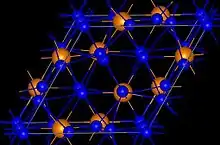Copper(I) phosphide
Copper phosphide, Cu3P, also copper(I) phosphide, cuprous phosphide, cuprophosphorus and phosphor copper, is a compound of copper and phosphorus, a phosphide of copper. It has the appearance of yellowish-grey very brittle mass of crystalline structure. It does not react with water.
 | |
| Names | |
|---|---|
| IUPAC name
copper(I) phosphide | |
| Other names
copper phosphide, cuprous phosphide | |
| Identifiers | |
3D model (JSmol) |
|
| ChemSpider | |
| ECHA InfoCard | 100.031.485 |
PubChem CID |
|
CompTox Dashboard (EPA) |
|
| |
| |
| Properties | |
| Cu3P | |
| Molar mass | 221.6127 g/mol |
| Appearance | yellowish grey crystals |
| Melting point | 900 °C (1,650 °F; 1,170 K) |
| -33.0·10−6 cm3/mol | |
| Structure | |
| Na 3As (hexagonal, hP24)[1][2] | |
| P63cm, No. 185 | |
| Hazards | |
| NIOSH (US health exposure limits): | |
PEL (Permissible) |
TWA 1 mg/m3 (as Cu)[3] |
REL (Recommended) |
TWA 1 mg/m3 (as Cu)[3] |
IDLH (Immediate danger) |
TWA 100 mg/m3 (as Cu)[3] |
Except where otherwise noted, data are given for materials in their standard state (at 25 °C [77 °F], 100 kPa).
Infobox references | |
Recent crystallographic investigations have proven Cu3P to be copper deficient, which means that the sum formula of this compound is more accurately expressed as Cu3−xP.[4]
Copper phosphide has a role in copper alloys, namely in phosphor bronze. It is a very good deoxidizer of copper.
Copper phosphide can be produced in a reverberatory furnace or in a crucible, e.g. by a reaction of red phosphorus with a copper-rich material. It can also be prepared photochemically, by irradiating cupric hypophosphite with ultraviolet radiation.[5] It can also be produced by reducing copper(II) phosphate with aluminum metal[6]
When subjected to ultraviolet light, copper phosphide shows fluorescence.
A blue-black film of copper phosphide forms on white phosphorus when subjected to a solution of copper salt; wounds containing particles of phosphorus therefore have to be washed with 1% solution of copper sulfate. The particles then can be easily removed, which is helped by their fluorescence. Formation of protective layer of copper phosphide is also used in cases of phosphorus ingestion, when gastric lavage with copper sulfate is employed as part of the cure.[7]
References
- Olofsson, Olle; Holmlund, Lars; Ingri, Nils; Tricker, M. J.; Svensson, Sigfrid (1972). "The Crystal Structure of Cu3P". Acta Chemica Scandinavica. 26: 2777–2787. doi:10.3891/acta.chem.scand.26-2777.
- Wolff, Alexander; Doert, Thomas; Hunger, Jens; Kaiser, Martin; Pallmann, Julia; Reinhold, Romy; Yogendra, Sivatmeehan; Giebeler, Lars; Sichelschmidt, Jörg; Schnelle, Walter; Whiteside, Rachel; Gunaratne, H. Q. Nimal; Nockemann, Peter; Weigand, Jan J.; Brunner, Eike; Ruck, Michael (2018-10-23). "Low-Temperature Tailoring of Copper-Deficient Cu 3– x P—Electric Properties, Phase Transitions, and Performance in Lithium-Ion Batteries". Chemistry of Materials. 30 (20): 7111–7123. doi:10.1021/acs.chemmater.8b02950.
- NIOSH Pocket Guide to Chemical Hazards. "#0150". National Institute for Occupational Safety and Health (NIOSH).
- Wolff, Alexander; Doert, Thomas; Hunger, Jens; Kaiser, Martin; Pallmann, Julia; Reinhold, Romy; Yogendra, Sivatmeehan; Giebeler, Lars; Sichelschmidt, Jörg (2018-10-23). "Low-Temperature Tailoring of Copper-Deficient Cu 3– x P—Electric Properties, Phase Transitions, and Performance in Lithium-Ion Batteries" (PDF). Chemistry of Materials. 30 (20): 7111–7123. doi:10.1021/acs.chemmater.8b02950. ISSN 0897-4756.
- "Electrophotographic elements and processes. United States Patent 4113484". Retrieved 2009-06-06.
- "Phosphorus - Sciencemadness Wiki". www.sciencemadness.org. Retrieved 2022-08-21.
- "Copper Poisoning: Introduction". Retrieved 2009-06-06.